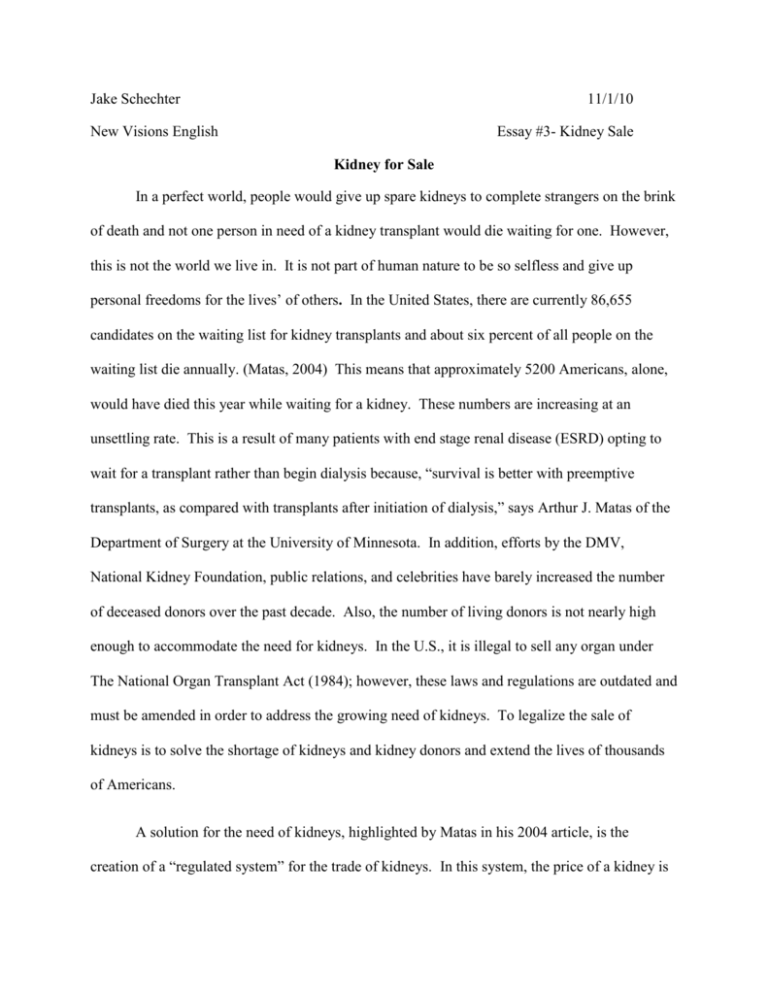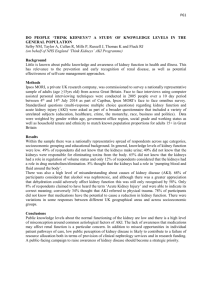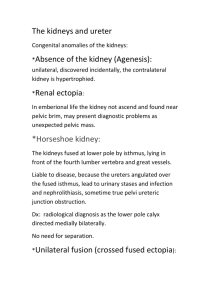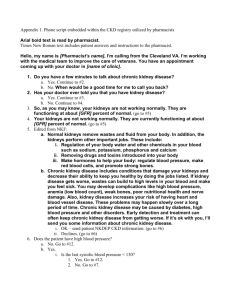New Visions English Essay #3- Kidney Sale
advertisement

Jake Schechter 11/1/10 New Visions English Essay #3- Kidney Sale Kidney for Sale In a perfect world, people would give up spare kidneys to complete strangers on the brink of death and not one person in need of a kidney transplant would die waiting for one. However, this is not the world we live in. It is not part of human nature to be so selfless and give up personal freedoms for the lives’ of others. In the United States, there are currently 86,655 candidates on the waiting list for kidney transplants and about six percent of all people on the waiting list die annually. (Matas, 2004) This means that approximately 5200 Americans, alone, would have died this year while waiting for a kidney. These numbers are increasing at an unsettling rate. This is a result of many patients with end stage renal disease (ESRD) opting to wait for a transplant rather than begin dialysis because, “survival is better with preemptive transplants, as compared with transplants after initiation of dialysis,” says Arthur J. Matas of the Department of Surgery at the University of Minnesota. In addition, efforts by the DMV, National Kidney Foundation, public relations, and celebrities have barely increased the number of deceased donors over the past decade. Also, the number of living donors is not nearly high enough to accommodate the need for kidneys. In the U.S., it is illegal to sell any organ under The National Organ Transplant Act (1984); however, these laws and regulations are outdated and must be amended in order to address the growing need of kidneys. To legalize the sale of kidneys is to solve the shortage of kidneys and kidney donors and extend the lives of thousands of Americans. A solution for the need of kidneys, highlighted by Matas in his 2004 article, is the creation of a “regulated system” for the trade of kidneys. In this system, the price of a kidney is fixed and money is paid to the “vendor” of the kidney by a government or government-approved agency. The recipient of the kidney is then determined algorithmically, similarly to how deceased donors are determined, giving all people on the waiting list the opportunity to obtain one. Specific standards must be met to become a vendor, ensuring the safety of the recipient. Regulations protecting the vendor are also necessary. A regulated market is better than a free market in that a free market favors the highest bidder; most of the money is paid to brokers and the opportunity for the poor to receive a kidney is greatly decreased. In addition, because the regulated system offers a chance for all persons on the waiting list to obtain a vendor kidney and regulations, such as age, would be included, the exploitation of children, similar to the fictional case of Anne Fitzgerald in Jody Picoult’s novel, My Sisters Keeper, would greatly decrease. Talks concerning the cost of kidneys would be a touchy subject. However, it is also touchy to talk of the people who are dying while waiting for kidneys in the system of today. Also, the payment of vendors may be “cost-neutral,” (Matas, pg.3) or even cost-effective to the health care system considering the cost of transplants during dialysis. The regulated system is not a perfect one, however, it is more ideal than the current system that leaves an increasing number of people with ESRD, eligible for transplantation, dead yearly. The major argument for the regulated sale of kidneys is simple: increase the amount of kidney donations by adding a financial incentive, resulting in the decrease of deaths while on the transplant waiting list. While the average wait for a deceased kidney donation today is more than five years, people are dying. Also, a regulated system would reward both the kidney vendor (in money) and the kidney recipient (with a new kidney), while in the current system, donors do not benefit and patients with ESRD die. Most parties involved in kidney transplantation of today, such as physicians, specialists, insurance companies, and other health care agencies, already benefit financially. In addition, in the 1980’s, when the National Organ Transplant Act (NOTA) was passed, immunosuppressant drugs were basic, donations from living donors were uncommon because deceased organs were seen to be just as useful as living ones, and the ability to fight infection was not as advanced as today’s. Therefore, it was in these circumstances that the sale of organs was condemned by NOTA. (Matas, 2004. Pg.1) Now, medical advancements in immunosuppressants and infection control and the fact that the wait for a deceased kidney is at least five years, it is not only illogical, but also fiscally irresponsible to deny the sale of kidneys to those who would, otherwise, die. There are several major augments against the sale of kidneys: (1) the poor are likely to be exploited, being more likely to sell a kidney than the rich; (2) harm to the vendor; (3) regret by the vendor. Before these are discussed, it must be mentioned that any valid argument against the sale of kidneys must concurrently allow donations. The ‘exploitation of the poor’ argument has some fundamental flaws. Essentially, it argues that, because of financial reasons, the poor will be more likely to sell their kidneys than the rich. The major flaw of the argument is that ‘exploitation’ implies that the player it is directed to (the poor) is at a total loss. However, in a regulated system, one cannot say that, in exchange for a body part, the gain of money necessary raising a child or paying off a mortgage is immoral. Therefore, any type of financial transaction would, somehow, improve the life of the vendor, making the argument in-valid. In many cases, the potential vendor is often worse-off keeping the kidney rather than selling it. Also, risk is a part of the argument; however, risk is cannot be seriously considered as an integral part of the argument because the risk of a kidney transplant by donation is the same by sale. The ‘harm’ argument is based on the fact that some physical harm, including death, would come to the vendor. However, as stated above, the risk of harm by a kidney sale and donation are the same. The argument holds no weight. The ‘regret’ argument has a few essential ideas: the financial incentive will cloud the judgment of the potential vendor and that the vendor will be limited in some ‘high-risk’ activities. There is no financial coercion, or, in other words, no one is making anyone sell their organs unwillingly. All risk is calculated and the potential vendor would be protected by the numerous safety regulations implemented by the government, and mandatory education would be one of those regulations. A vendor would be properly informed of all activities, such as alcohol consumption, contact sports, and various medications, that would be potentially dangerous. The choice to sell one’s kidney would be a hard one, but, nevertheless, a voluntary one. In addition, there are calculated risk in all financial transactions and that risk is to be unhappy with the outcome; for example, investing in stock and losing all of those investments in an market crash, starting a new business, buying a new house, or buying a new car. In many cases, the outcomes of transactions are unfavorable, but this is all part of calculated risk. The implementing of a regulated system of living kidney trade would be the end of extended waiting for kidneys and greatly reduce the mortality rate of people with ESRD. As of now, kidneys should be the only organs available for regulated sale because of the substantial knowledge medical professionals have pertaining to the long term effects of kidney transplants. Also, a kidney transplant is much safer than most other living transplants. However, with the implication of said system, there would be much open discussion concerning the regulated sale of all other organs such as the liver, lung, and pancreas. In order for a regulated kidney trade system to be implemented, open discussion must occur and many practicalities must be considered and doubts resolved. Bibliography Matas, A. J. (2004, Agust 25). The Case for Living Kidney Sales: Rationale, Objections and Concerns. Hods.org: http://www.hods.org/pdf/kidneymatassales%5B1%5D.pdf. Retrieved October 29, 2010, 2:34 PM. OPTN. (2010, October 22). Current U.S. Waiting List Overall by Organ. OPTN: Organ Procurement and Transplantation Network: http://optn.transplant.hrsa.gov/latestData/rptData.asp. Retrieved October 29, 2010 3:08 PM National Kidney Foundation. Kidney Disease - A Growing Problem: kidney.org/news/newsroom/fs_new/KDaGrowingProblem.cfm. Retrieved October 29, 2010, 3:20 PM









